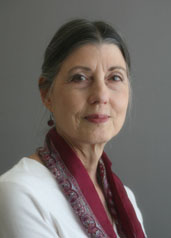By Betty Bland
Originally printed in the JULY-AUGUST 2008 issue of Quest magazine.
Citation: Bland, Betty. "The Light of the World." Quest 96.4 (JULY-AUGUST 2008):124-125.

SUNLIGHT STREAMING THROUGH BEAUTIFUL stained glass windows fills my earliest memories of religious or devotional feelings. Sitting in my family's regular Sunday morning pew and understanding little of what was going on, I would gaze at those luminous pictures of a loving shepherd holding the little lamb in his arms, or a kindly bearded man knocking to be given entry at a door draped with bunches of grapes. There was no shortage of beautiful church music and, on occasion after communion, the choir would gather around the altar rail and sing "The Lord Bless You and Keep You."
These experiences were outside the realm of my intellectual analysis, but they deeply imprinted on my heart a spiritual connection with the "other" that was not particularly conscious but a constant background presence. It did not make me religious, or even good, for that matter. In fact, "mischief" was said to be my middle name. However, in times of trouble or uncertainty the interior connection was a very present support. These experiences provided a mysterious access to an inner world that otherwise might have been invisible to me.
Depending on the individual, there are many different reactions to this weekly ritual, ranging from total boredom and resentment to conscious and life-changing inspiration. A few poignant symbols, connected and well presented, have the potential of striking an inner chord and mysteriously calling forth an intuitive response. Although unpredictable to some extent, the presence of inspiration is dependent on beauty, intentionality, and heart.
Beauty and culture were the two elixirs to humanity's evils identified by Nicholas Roerich in his writings. He felt that beauty had a unique way of speaking to one's soul and drawing out the best. Plato also identified Beauty as one of the trio of divine attributes along with the Good and the True. Although it is true that beauty is in the eye of the beholder, there is a certain balance and harmony within the form one might call beautiful that creates a sense of pleasure, and gives a certain lift to the spirit.
But beauty alone does not have transformative power. Perhaps this is why Roerich felt the need to include culture as one of the essential attributes for saving humanity. Intentionality, or understanding, has to imbue the beautiful with meaning so that some message of inspiration is transmitted. In this context the beauty is not for its own sake but is like the finger pointing at the moon, useful but not the end goal in itself, lest it become a hollow mockery. Inherent within the beauty of a sunset is a sense of awe and vastness of the whole of creation, thus inspiring the viewer to think beyond the small self.
The most important element, however, is what I call heart—the light of spirit which is a unitive, all-encompassing love. It is like the sunshine that streams through the many-colored windows to translate the darkened glass into colorful images. This spiritual light has the power to shine through and transform elements of this world from empty idols into icons or symbolic representations of a greater reality. Meaningful symbols or symbolic actions are, as expressed in the Book of Common Prayer of the Episcopal Church, outward and visible signs of inward and spiritual grace.
I mention the Christian idiom because that is my religion of birth and choice, but the use of symbols is universal to all religious traditions. Symbolic transmission of knowledge, in whatever system, is a gift for our human unfoldment. We have the unique ability to look into a metaphor and to see beyond it into unspoken truths. For this reason the preferred transmission of religious teachings has always been in metaphor and symbol. Certainly Madame Blavatsky chose the obscure and poetic Stanzas of Dhyzan as the foundational structure for her opus magnum, The Secret Doctrine.
As products of a materialistic, scientific age, we sometimes might forget the efficacy of using our inner light to look into and appreciate the subtleties of a symbolic or ritualistic approach to gaining insight into reality. Each of us would do well to draw to ourselves those symbols that inspire and encourage us. Moreover, we might remember that our regular practice of using them imbues them with the energy and power of heart and spiritual light. Each grain of practice helps to build a mountain of experience.
Yet, with routine and familiarity, we may forget the original inspiration. In fact, the one real danger in the use of symbols for our spiritual nurture is that we might lose sight of their true nature, getting lost in their outer forms, rather than drawing on the power of their beauty with intentionality and heart. But with conscientious effort we will access our inner light and, in the finding of it, develop a luminosity that becomes a beacon of hope for others.
In the afterword to Esoteric Christianity, Annie Besant inspires us to seek the mystery veiled in allegory in order that we might kindle our lights of intuition when she writes:
[We] have only lifted a corner of the Veil that hides the Virgin of Eternal Truth from the careless eyes of men. The hem of her garment only has been seen, heavy with gold, richly dight with pearls. Yet even this, as it waves slowly, breathes out celestial fragrances—the sandal and rose-attar of fairer worlds than ours.

